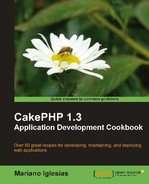This recipe shows how to use Containable to change some of the parameters that affect model bindings.
To go through this recipe, we need some sample tables to work with.
- Create a table named
users, using the following SQL statement:CREATE TABLE `users`( `id` INT UNSIGNED AUTO_INCREMENT NOT NULL, `name` VARCHAR(255) NOT NULL, `email` VARCHAR(255) NOT NULL, PRIMARY KEY(`id`) );
- Create a table named
profiles, using the following SQL statement:CREATE TABLE `profiles`( `id` INT UNSIGNED AUTO_INCREMENT NOT NULL, `user_id` INT UNSIGNED NOT NULL, `website` VARCHAR(255) default NULL, `birthdate` DATE default NULL, PRIMARY KEY(`id`), KEY `user_id`(`user_id`), CONSTRAINT `profiles__users` FOREIGN KEY(`user_id`) REFERENCES `users`(`id`) );
- Create a table named
articles, using the following SQL statement:CREATE TABLE `articles`( `id` INT UNSIGNED AUTO_INCREMENT NOT NULL, `user_id` INT UNSIGNED NOT NULL, `title` VARCHAR(255) NOT NULL, `body` TEXT NOT NULL, `published` TINYINT NOT NULL default 1, `created` DATETIME NOT NULL, `modified` DATETIME NOT NULL, PRIMARY KEY(`id`), KEY `user_id`(`user_id`), CONSTRAINT `articles__users` FOREIGN KEY(`user_id`) REFERENCES `users`(`id`) );
- Add some sample data, using the following SQL statements:
INSERT INTO `users`(`id`, `name`, `email`) VALUES (1, 'John Doe', '[email protected]'), (2, 'Jane Doe', '[email protected]'), INSERT INTO `profiles`(`user_id`, `website`, `birthdate`) VALUES (1, 'http://john.example.com', '1978-07-13'), (2, NULL, '1981-09-18'), INSERT INTO `articles`(`user_id`, `title`, `body`, `published`, `created`, `modified`) VALUES (1, 'John's Post 1', 'Body for John's Post 1', 1, NOW(), NOW()), (1, 'John's Post 2', 'Body for John's Post 2', 1, NOW(), NOW()), (1, 'John's Post 3', 'Body for John's Post 3', 0, NOW(), NOW()), (1, 'John's Post 4', 'Body for John's Post 4', 1, NOW(), NOW()), (2, 'Jane's Post 1', 'Body for Jane's Post 1', 1, NOW(), NOW());
- Add the
Containablebehavior to all your models by following the recipe Adding Containable to all models. - Now we need to create the main model. Create a file named
user.phpand place it in yourapp/modelsfolder with the following contents:<?php class User extends AppModel { public $hasOne = array('Profile'), public $hasMany = array('Article'), } ?>
If we want to obtain the first User record together with the Article records that the User owns, but ordered by latest articles first, we use the order binding setting (we also use the fields setting to limit the fields returned for each Article):
$user = $this->User->find('first', array(
'contain' => array(
'Article' => array(
'fields' => array('Article.title'),
'order' => array(
'Article.created' => 'desc',
'Article.id' => 'desc'
)
)
)
));
Using our sample data, the above query will result in the following array structure:
array( 'User' => array( 'id' => '1', 'name' => 'John Doe', 'email' => '[email protected]', ), 'Article' => array( array( 'title' => 'John's Post 4', 'user_id' => '1' ), array( 'title' => 'John's Post 3', 'user_id' => '1' ), array( 'title' => 'John's Post 2', 'user_id' => '1' ), array( 'title' => 'John's Post 1', 'user_id' => '1' ) ) )
If we want to get the same data, but make sure we only obtain the latest Article a User has written, we use the limit binding setting:
$user = $this->User->find('first', array(
'contain' => array(
'Article' => array(
'fields' => array('Article.title'),
'order' => array(
'Article.created' => 'desc',
'Article.id' => 'desc'
),
'limit' => 1
)
)
));
Using our sample data, the above query will result in the following array structure:
array( 'User' => array( 'id' => '1', 'name' => 'John Doe', 'email' => '[email protected]', ), 'Article' => array( array( 'title' => 'John's Post 4', 'user_id' => '1' ) ) )
Another option that is useful on some scenarios is offset, applicable to the hasMany and hasAndBelongsToMany bindings. Using the example above, we now want to obtain the two most recent articles a User created, after the latest Article.
$user = $this->User->find('first', array(
'contain' => array(
'Article' => array(
'fields' => array('Article.title'),
'order' => array(
'Article.created' => 'desc',
'Article.id' => 'desc'
),
'limit' => 2,
'offset' => 1
)
)
));
The returned data structure now looks like this:
array( 'User' => array( 'id' => '1', 'name' => 'John Doe', 'email' => '[email protected]', ), 'Article' => array( array( 'title' => 'John's Post 3', 'user_id' => '1' ), array( 'title' => 'John's Post 2', 'user_id' => '1' ) ) )
The Containable behavior uses the built-in bindModel() method defined in CakePHP's Model class to alter the binding settings defined in the contain find setting.
It goes through the defined bindings and checks to see whether there are defined binding settings. If there are, it passes them to the bindModel() method for each of the specified bindings.
Some binding settings make sense only on some relationship types. For example, the limit setting used previously would not be useful on belongsTo or hasOne relationships.
The following list includes which settings can be specified for each relationship type:
belongsTo: className, conditions, foreignKey, order.hasOne: className, conditions, foreignKey, order.hasMany: className, conditions, finderQuery, foreignKey, limit, offset, order.hasAndBelongsToMany: associationForeignKey, className, conditions, deleteQuery, finderQuery, foreignKey, insertQuery, joinTable, limit, offset, order, unique, with.
